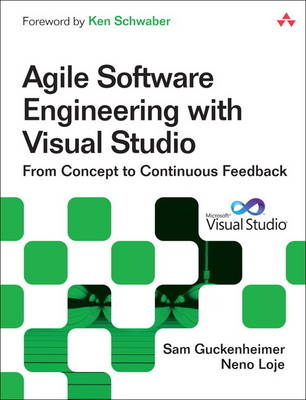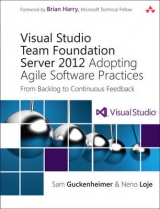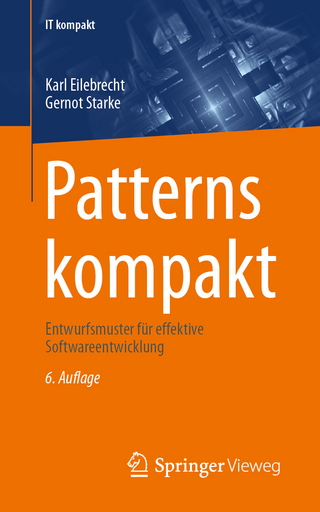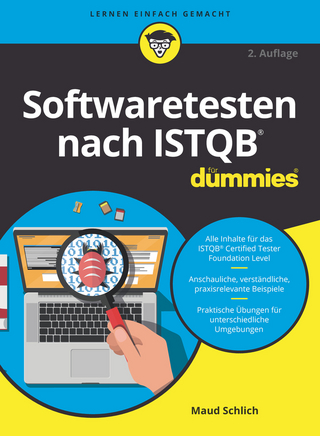
Agile Software Engineering with Visual Studio
Addison-Wesley Educational Publishers Inc (Verlag)
978-0-321-68585-8 (ISBN)
- Titel erscheint in neuer Auflage
- Artikel merken
This book is the definitive guide to the application of agile development with Scrum and modern software engineering practices using Visual Studio 2010. You’ll learn how to use Visual Studio 2010 to empower and engage multidisciplinary, self-managing teams and provide the transparency they need to maximize productivity. Along the way, Guckenheimer and Loje help you overcome every major impediment that leads to stakeholder dissatisfaction—from mismatched schedules to poor quality, blocked builds to irreproducible bugs, and technology “silos” to geographic “silos.”
Coverage includes
• Accelerating the “flow of value” to customers in any software project, no matter how large or complex
• Empowering high-performance software teams and removing overhead in software delivery
• Automating “burndowns” and using dashboards to gain a real-time, multidimensional view of quality and progress
• Using Visual Studio 2010 to reduce or eliminate “no repro” bugs
• Automating deployment and virtualizing test labs to make continuous builds deployable
• Using Test Impact Analysis to quickly choose the right tests based on recent code changes
• Working effectively with sources, branches, and backlogs across distributed teams
• Sharing code, build automation, test, project and other data across .NET and Java teams
• Uncovering hidden architectural patterns in legacy software, so you can refactor changes more confidently
• Scaling Scrum to large, distributed organizations
Whatever your discipline, this book will help you use Visual Studio 2010 to focus on what really matters: building software that delivers exceptional value sooner and keeps customers happy far into the future.
Foreword by Ken Schwaber
It is my honor to write a foreword for Sam’s book, Agile Software Delivery with Visual Studio. Sam is both a practitioner of software development, as well as a scholar. I have worked with Sam for the last two years to merge Scrum with modern engineering practices and an excellent toolset, Microsoft’s VS 2010. We are both indebted to Aaron Bjork of Microsoft, who developed the Scrum template that instantiates Scrum in VS 2010 through the Scrum Template.
I do not want Scrum to be prescriptive. I left many holes, such as what as the syntax and organization of the Product Backlog, the engineering practices that turned Product Backlog items into a potentially shippable increment, and the magic that would create self-organizing teams. Sam has superbly described one way of filling in these holes in his book. He describes the techniques and tooling, as well as the rationale of the approach that he prescribes. He does this in detail, with scope and humor. Since I have worked with Microsoft since 2004 and Sam since 2009 on these practices and tooling, I am delighted. Our first launch was a course, the Professional Scrum Developer .NET course, that taught developers how to use solid increments using modern engineering practices on VS 2010 — working in self-organizing, cross-functional teams. Sam’s book is the bible to this course and more, laying it all out in detail and philosophy. If you are on a Scrum Team building software with .NET technologies, this is the book for you. If you are using Java, this book is compelling enough to read anyway, and maybe worth switching to .NET.
When we devised and signed the Agile Manifesto in 2001, our first value was “Individuals and interactions over processes and tools.” Well, we have the processes and tools nailed for the Microsoft environment. In Sam’s book, we have something developers, who are also people, can use to understand the approach and value of the processes and tools. Now the really hard work, people. After twenty years of being treated as resources, becoming accountable, creative, responsible people is hard. Our first challenge will be the people who manage the developers. They could use the metrics from the VS 2010 tooling to micro-manage the processes and developers, squeezing the last bit of creativity out and leaving Agility flat. Or, they could use the metrics from the tools to understand the challenges facing the developers. They could then coach and lead them to a better, more creative and productive place. This is the challenge of any tool. It may be excellent, but how it is used will determine its success.
Thanks for the book, Sam.
Praise for Agile Software Engineering with Visual Studio
“Agile dominates projects increasingly from IT to product and business development, and Sam Guckenheimer and Neno Loje provide pragmatic context for users seeking clarity and specifics with this book. Their knowledge of past history and current practice, combined with acuity and details about Visual Studio’s agile capabilities, enable a precise path to execution. Yet their voice and advice remain non-dogmatic and wise. Their examples are clear and relevant, enabling a valuable perspective to those seeking a broad and deep historical background along with a definitive understanding of the way in which Visual Studio can incorporate agile approaches.”
—Melinda Ballou, Program Director, Application Lifecycle Management and Executive Strategies Service, International Data Corporation (IDC)
“Sam Guckenheimer and Neno Loje have forgotten more about software development processes than most development `gurus’ ever knew, and that’s a good thing! In Agile Software Engineering with Visual Studio, Sam and Neno distill the essence of years of hard-won experience and hundreds of pages of process theory into what really matters—the techniques that high performance software teams use to get stuff done. By combining these critical techniques with examples of how they work in Visual Studio, they created a de-facto user guide that no Visual Studio developer should be without.”
—Jeffrey Hammond, Principal Analyst, Forrester Research
“If you employ Microsoft’s Team Foundation Server and are considering Agile projects, this text will give you a sound foundation of the principles behind its agile template and the choices you will need to make. The insights from Microsoft’s own experience in adopting agile help illustrate challenges with scale and the issues beyond pure functionality that a team needs to deal with. This book pulls together into one location a wide set of knowledge and practices to create a solid foundation to guide the decisions and effective transition, and will be a valuable addition to any team manager’s bookshelf.”
—Thomas Murphy, Research Director, Gartner
“This book presents software practices you should want to implement on your team and the tools available to do so. It paints a picture of how first class teams can work, and in my opinion, is a must read for anyone involved in software development. It will be mandatory reading for all our consultants.”
—Claude Remillard, President, InCycle
“This book is the perfect tool for teams and organizations implementing agile practices using Microsoft’s Application Lifecycle Management platform. It proves disciplined engineering and agility are not at odds; each needs the other to be truly effective.”
—David Starr, Scrum.org
“Sam Guckenheimer and Neno Loje have written a very practical book on how Agile teams can optimize their practices with Visual Studio. It describes not only how Agile and Visual Studio work, but also the motivation and context for many of the functions provided in the platform. If you are using Agile and Visual Studio, this book should be a required read for everyone on the team. If you are not using Agile or Visual Studio, then reading this book will describe a place that perhaps you want to get to with your process and tools.”
—Dave West, Analyst, Forrester Research
“Sam Guckenheimer and Neno Loje are leading authorities on agile methods and Visual Studio. The book you are holding in your hand is the authoritative way to bring these two technologies together. If you are a Visual Studio user doing agile, this book is a must read.”
—Dr. James A. Whittaker, Software Engineering Director Google
“Agile development practices are a core part of modern software development. Drawing from our own lessons in adopting agile practices at Microsoft, Sam Guckenheimer and Neno Loje not only outline the benefits, but also deliver a hands-on, practical guide to implementing those practices in teams of any size. This book will help your team get up and running in no time!”
—Jason Zander, Corporate Vice President, Microsoft Corporation
Sam Guckenheimer When I wrote the predecessor of this book, I had been at Microsoft less than three years. I described my history like this:I joined Microsoft in 2003 to work on Visual Studio Team System (VSTS), the new product line that was just released at the end of 2005. As the group product planner, I have played chief customer advocate, a role that I have loved. I have been in the IT industry for twenty-some years, spending most of my career as a tester, project manager, analyst, and developer. As a tester, I’ve always understood the theoretical value of advanced developer practices, such as unit testing, code coverage, static analysis, and memory and performance profiling. At the same time, I never understood how anyone had the patience to learn the obscure tools that you needed to follow the right practices. As a project manager, I was always troubled that the only decent data we could get was about bugs. Driving a project from bug data alone is like driving a car with your eyes closed and only turning the wheel when you hit something. You really want to see the right indicators that you are on course, not just feel the bumps when you stray off it. Here, too, I always understood the value of metrics, such as code coverage and project velocity, but I never understood how anyone could realistically collect all that stuff. As an analyst, I fell in love with modeling. I think visually, and I found graphical models compelling ways to document and communicate. But the models always got out of date as soon as it came time to implement anything. And the models just didn’t handle the key concerns of developers, testers, and operations. In all these cases, I was frustrated by how hard it was to connect the dots for the whole team. I loved the idea in Scrum (one of the Agile processes) of a “single product backlog”—one place where you could see all the work—but the tools people could actually use would fragment the work every which way. What do these requirements have to do with those tasks, and the model elements here, and the tests over there? And where’s the source code in that mix? From a historical perspective, I think IT turned the corner when it stopped trying to automate manual processes and instead asked the question, “With automation, how can we reengineer our core business processes?” That’s when IT started to deliver real business value. They say the cobbler’s children go shoeless. That’s true for IT, too. While we’ve been busy automating other business processes, we’ve largely neglected our own. Nearly all tools targeted for IT professionals and teams seem to still be automating the old manual processes. Those processes required high overhead before automation, and with automation, they still have high overhead. How many times have you gone to a 1-hour project meeting where the first 90 minutes were an argument about whose numbers were right? Now, with Visual Studio, we are seriously asking, “With automation, how can we reengineer our core IT processes? How can we remove the overhead from following good process? How can we make all these different roles individually more productive while integrating them as a high performance team?” Obviously, that’s all still true. Neno Loje I started my career as a software developer—first as a hobby, later as profession. At the beginning of high school, I fell in love with writing software because it enabled me to create something useful by transforming an idea into something of actual value for someone else. Later, I learned that this was generating customer value. However, the impact and value were limited by the fact that I was just a single developer working in a small company, so I decided to focus on helping and teaching other developers. I started by delivering pure technical training, but the topics soon expanded to include process and people, because I realized that just introducing a new tool or a technology by itself does not necessarily make teams more successful. During the past six years as an independent ALM consultant and TFS specialist, I have helped many companies set up a team environment and software development process with VS. It has been fascinating to watch how removing unnecessary, manual activities makes developers and entire projects more productive. Every team is different and has its own problems. I’ve been surprised to see how many ways exist (both in process and tools) to achieve the same goal: deliver customer value faster though great software. When teams look back at how they worked before, without VS, they often ask themselves how they could have survived without the tools they use now. However, what had changed from the past were not only the tools, but also the way they work as a team. Application Lifecycle Management and practices from the Agile Consensus help your team to focus on the important things. VS and TFS are a pragmatic approach to implement ALM (even for small, nondistributed teams). If you’re still not convinced, I urge you to try it out and judge for yourself.
Foreword xvii
Preface xix
Acknowledgements xxvi
About the Authors xxvii
Chapter 1: The Agile Consensus 1
The Origins of Agile 1
Agile Emerged to Handle Complexity 2
Empirical Process Models 4
A New Consensus 4
Scrum 6
An Example 12
Summary 15
End Notes 16
Chapter 2: Scrum, Agile Practices, and Visual Studio 19
Visual Studio and Process Enactment 20
Process Templates 21
Process Cycles and TFS 23
Inspect and Adapt 36
Task Boards 36
Kanban 38
Fit the Process to the Project 39
Summary 42
End Notes 43
Chapter 3: Product Ownership 45
What Is Product Ownership? 46
Scrum Product Ownership 50
Release Planning 51
Qualities of Service 63
How Many Levels of Requirements 67
Summary 70
End Notes 70
Chapter 4: Running the Sprint 73
Empirical over Defined Process Control 75
Scrum Mastery 76
Use Descriptive Rather Than Prescriptive Metrics 81
Answering Everyday Questions with Dashboards 86
Choosing and Customizing Dashboards 94
Using Microsoft Outlook to Manage the Sprint 95
Summary 96
End Notes 96
Chapter 5: Architecture 99
Architecture in the Agile Consensus 100
Exploring Existing Architectures 103
Summary 121
End Notes 123
Chapter 6: Development 125
Development in the Agile Consensus 126
The Sprint Cycle 127
Keeping the Code Base Clean 128
Detecting Programming Errors Early 135
Catching Side Effects 152
Preventing Version Skew 160
Making Work Transparent 168
Summary 169
End Notes 171
Chapter 7: Build and Lab 173
Cycle Time 174
Defining Done 175
Continuous Integration 177
Automating the Build 179
Elimination of Waste 196
Summary 201
End Notes 202
Chapter 8: Test 203
Testing in the Agile Consensus 204
Testing Product Backlog Items 207
Actionable Test Results and Bug Reports 212
Handling Bugs 218
Which Tests Should Be Automated? 219
Automating Scenario Tests 220
Load Tests, as Part of the Sprint 225
Production-Realistic Test Environments 230
Risk-Based Testing 232
Summary 235
End Notes 236
Chapter 9: Lessons Learned at Microsoft Developer Division 239
Scale 240
Business Background 241
Improvements After 2005 245
Results 254
Law of Unintended Consequences 255
What’s Next? 259
End Notes 259
Chapter 10: Continuous Feedback 261
Agile Consensus in Action 262
The Next Version 263
Product Ownership and Stakeholder Engagement 264
Staying in the Groove 270
Testing to Create Value 275
TFS in the Cloud 275
Conclusion 276
End Notes 279
Index 281
| Verlagsort | New Jersey |
|---|---|
| Sprache | englisch |
| Maße | 230 x 179 mm |
| Gewicht | 504 g |
| Themenwelt | Mathematik / Informatik ► Informatik ► Software Entwicklung |
| ISBN-10 | 0-321-68585-7 / 0321685857 |
| ISBN-13 | 978-0-321-68585-8 / 9780321685858 |
| Zustand | Neuware |
| Haben Sie eine Frage zum Produkt? |
aus dem Bereich



